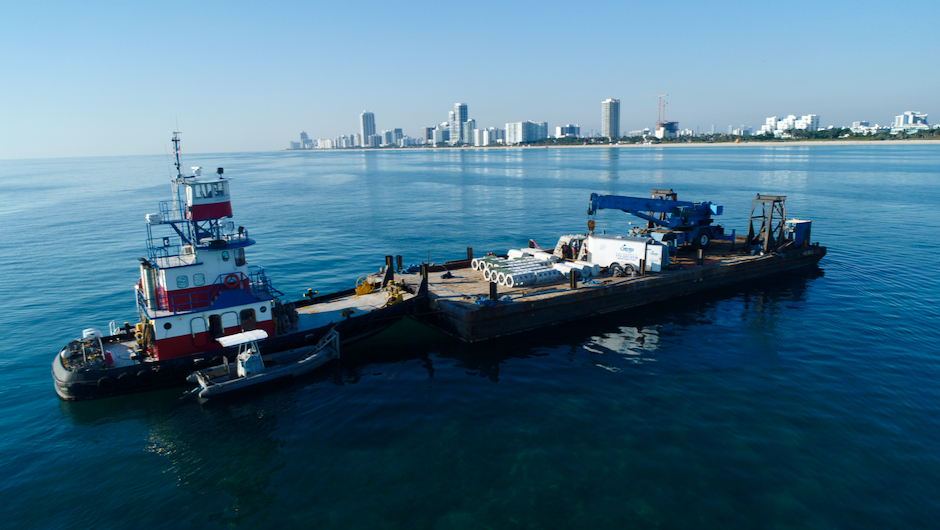Miami Beach, Fl.—A team of marine scientists and engineers from the University of Miami Rosenstiel School of Marine, Atmospheric, and Earth Science, and the College of Engineering,
in collaboration with the City of Miami Beach, deployed two innovative artificial reef structures off Miami Beach on Wednesday, March 1, 2023, to kick off a two-year project called ECoREEF - Engineering Coastal Resilience Through Hybrid Reef Restoration.
The project aims to create a science-based design framework to develop and test coastal resilience strategies that combine grey (cement-based) and green (nature-based) restoration strategies such as hybrid reefs that can provide added protection against storm surge and powerful hurricanes along South Florida’s valuable and vulnerable coastline. During the project, scientists will be gathering data on wave attenuation and other hydrodynamic processes, as well as survivorship and growth of transplanted corals.
Previous studies have shown that shallow coral reefs can buffer up to 97 percent of the energy from waves and reduce flooding frequency and impacts, helping to prevent loss of life, property damage, and erosion.
Two ECoREEF units were deployed about 750 feet (231 meters) offshore of North Shore Oceanside Park, at 8328 Collins Avenue, at a depth of 14 feet (4 meters).
One of the structures is hollow and trapezoidal shaped with limestone boulders on its outer surface to mimic the texture of coral reefs and attract marine life. The second structure is a configuration of hollow, hexagonal SEAHIVETM units, which are perforated to let water flow through them. Both structures are manufactured using concrete with non-corrosive reinforcements for durability and biocompatibility purposes. Each structure is 19-feet (6 meters) long and approximately 6 feet (2 meters) tall, with each spaced about 16 feet (5 meters) apart.
Later this spring, Rosenstiel School marine scientists will outplant and field-test new approaches to making corals more resilient to warming temperatures. These corals will help further increase friction and dissipate wave energy.
“Due to the recent mortality of reef-building corals, our reefs have lost a lot of three-dimensional structure needed to help reduce wave energy,” said Diego Lirman, professor of marine biology and ecology and lead investigator for the project at the Rosenstiel School. “By combining the deployment of artificial reefs near the shoreline and planting these units with stress-tolerant corals, we aim to recover the lost services provided by healthy reefs such as coastal protection and habitat for associated organisms like fish and lobsters.”
The ECoREEF team also includes Andrew Baker, professor of marine biology and ecology, Brian Haus, professor of ocean sciences at the Rosenstiel School, Landolf Rhode-Barbarigos, assistant professor, College of Engineering, Sonia Chao, research associate professor, School of Architecture and Joytika Ramaprasad, professor, School of Communications.
The project began in 2018, with funding from the University’s Laboratory for Integrative Knowledge (U-LINK), which provided a platform for interdisciplinary research teams to explore solutions that address societal problems.
The team has tested smaller scale versions of the two hybrid reef designs in the Rosenstiel School’s Alfred C. Glassell, Jr., SUSTAIN Laboratory’s wind-wave tank, which can simulate category 5 hurricane force winds. Now, they plan to do similar measurements in the field by adding sensors both inside the structures and putting buoys with measuring instruments in the water around the structures.
"Designing structures to dissipate wave energy while providing a hospitable environment for corals has been a challenge” said Rhode-Barbarigos. “There are no design guidelines for nature.”
“We want to see how these two different alternatives for a hybrid, engineered structure and a natural reef compare,” Haus said. “This is a research installation, so we will be looking at it in a lot of ways, including monitoring currents and water flow. We will also do regular dive visits to the site to plant corals and monitor their growth.”
Local leaders in Miami Beach, who have worked with University of Miami researchers are eager to see the results.
"The launch of this experimental artificial reef marks a pivotal moment in our efforts to protect Miami Beach from coastal erosion and restore our coral ecosystem,” said Miami Beach Commissioner Ricky Arriola. “Not only will this innovative solution help safeguard our shores, but it will also drive eco-tourism and further establish Miami Beach as a leader in sustainable coastal management."
“We can’t wait to see how this hybrid reef grows,” added Miami Beach Chief Resilience Officer Amy Knowles. “Coral reefs are an important part of marine life and our coastal resilience to storm surge and sea level rise for Miami Beach, Resilient305, and our broader region.”
Additional funding was provided through grants from the City of Miami Beach. SEAHIVETM research and development was supported by the National Cooperative Highway Research Program.

